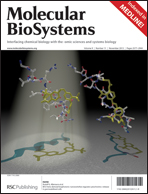Insights into the mechanism of interaction between trehalose-conjugated beta-sheet breaker peptides and Aβ(1–42) fibrils by molecular dynamics simulations†
Abstract
An attractive strategy to contrast the Alzheimer disease (AD) is represented by the development of β-sheet breaker


 Please wait while we load your content...
Please wait while we load your content...